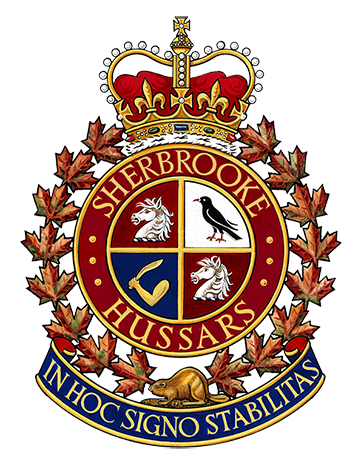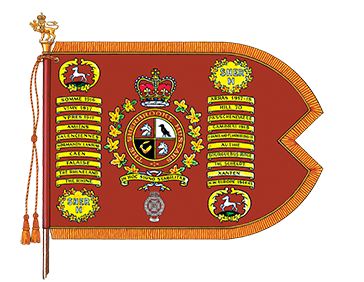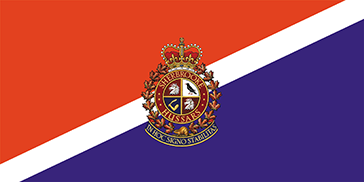The Sherbrooke Hussars
The official lineage of The Sherbrooke Hussars armour regiment.

Badge
Description
Quarterly first and fourth Gules a horse's head Argent upon a wreath Argent and Azure, second Argent a Cornish chough proper, third Sable a sinister arm embowed the hand grasping a kukri Or, all within an annulus Gules edged and inscribed SHERBROOKE HUSSARS in letters Or, ensigned by the Royal Crown and encircled by a wreath of autumn maple leaves proper surmounted in base by a beaver upon a log Or, set above a scroll Sable edged and inscribed IN HOC SIGNO STABILITAS in letters Or.
Symbolisme
The maple leaves and the beaver represent service to Canada, and the Crown, service to the Sovereign. The two horse heads represent the cavalry lineage of The Sherbrooke Regiment and the 7th/11th Hussars, the chough (bird) was taken from the coat of arms of the Aylmer family and represents the 11th Hussars, and the sinister arm and Kukri represent the image of an arm with a cavalry sabre formerly depicted in the badge of the 7th Hussars. "SHERBROOKE HUSSARS" is a form of the regimental title and "IN HOC SIGNO STABILITAS" is the motto of the regiment.
Motto
IN HOC SIGNO STABILITAS (Steadfast by this sign)
March
Regimental March of the Sherbrooke Hussars
Alliance
British Army
The Queen's Royal Hussars (The Queen's Own and Royal Irish); and The Royal Anglian Regiment
Guidon

Camp flag

Battle honours
The War of 1812
DEFENCE OF CANADA – 1812-1815 – DÉFENSE DU CANADA
Honorary Distinction
The non-emblazonable honorary distinction DEFENCE OF CANADA – 1812-1815 – DÉFENSE DU CANADA
The First World War
MOUNT SORREL; SOMME, 1916; Flers-Courcelette; Ancre Heights; ARRAS, 1917, '18; Vimy, 1917; HILL 70; YPRES, 1917; Passchendaele; AMIENS; Scarpe, 1918; HINDENBURG LINE; Canal du Nord; Cambrai, 1918; VALENCIENNES; SAMBRE; FRANCE AND FLANDERS, 1915-18.
The Second World War
NORMANDY LANDING; Authie; CAEN; The Orne; BOURGUÉBUS RIDGE; Faubourg de Vaucelles; St. André-sur-Orne; FALAISE; Falaise Road; Clair Tizon; The Laison; Antwerp-Turnhout Canal; THE SCHELDT; The Lower Maas; THE RHINELAND; The Hochwald; Xanten; THE RHINE; Emmerich-Hoch Elten; Zutphen, Deventer; NORTH-WEST EUROPE, 1944 1945.
Honorary Distinction
The badge of The Royal Rifles of Canada, with the year-date 1941, was awarded as an honorary distinction to the 7th/11th Hussars for significantly reinforcing The Royal Rifles of Canada during their operation in Hong Kong.
Lineage
This Reserve Force regiment originated on 21 September 1866 and incorporates the following regiments.
The Sherbrooke Hussars originated in Melbourne, Quebec on 21 September 1866, when the 'Sherbrooke Battalion of Infantry' was authorized to be formed.Footnote 1 It was redesignated the '53rd Sherbrooke Battalion of Infantry' on 15 March 1867.Footnote 2 On 22 March 1867, it was reorganized as two separate battalions designated the '53rd Melbourne Battalion of Infantry' (see below) and the '54th Sherbrooke Battalion of Infantry'.Footnote 3 It was redesignated: '53rd Sherbrooke Battalion of Infantry' on 10 May 1867;Footnote 4 '53rd Sherbrooke Regiment' on 8 May 1900;Footnote 5 'The Sherbrooke Regiment' on 29 March 1920;Footnote 6 'The Sherbrooke Regiment (MG)' on 15 December 1936;Footnote 7 'The Sherbrooke Regiment' on 1 February 1941;Footnote 8 '2nd (Reserve) Battalion, The Sherbrooke Regiment' on 7 November 1940;Footnote 9 '12th Armoured Regiment (Sherbrooke Regiment), RCAC' on 1 April 1946;Footnote 10 'The Sherbrooke Regiment (12th Armoured Regiment)' on 4 February 1949;Footnote 11 and 'The Sherbrooke Regiment (RCAC)' on 19 May 1958.Footnote 12 On 15 February 1965, it was amalgamated with the '7th/11th Hussars' (see below) and redesignated 'The Sherbrooke Hussars'.Footnote 13
Notes:
Upon redesignation as The Sherbrooke Regiment on 29 March 1920 (see above), it was organized as a two battalion regiment with the 1st Battalion (117th Battalion, CEF) on the Non Permanent Active Militia order of battle, and the 2nd Battalion (no CEF designation) on the Reserve order of battle. The reserve unit was disbanded on 14 December 1936 (GO 3/37).
The Sherbrooke Regiment was disbanded for the purpose of reorganization on 15 September 1920 and reorganized the same day (GO 253/20). This change was administrative and does not affect the lineage of the regiment.
The 7th/11th Hussars originated in Sherbrooke, Quebec on 21 September 1866, when the 'Sherbrooke Battalion of Infantry' was authorized to be formed.Footnote 14 It was redesignated the '53rd Sherbrooke Battalion of Infantry' on 15 March 1867.Footnote 15 On 22 March 1867, it was reorganized as two separate battalions, designated the '54th Sherbrooke Battalion of Infantry' (see above) and the '53rd Melbourne Battalion of Infantry'.Footnote 16 It was redesignated: '54th "Richmond" Battalion of Infantry' on 10 May 1867;Footnote 17 and '54th Richmond Regiment' on 8 May 1900.Footnote 18 It was converted to cavalry and redesignated the '11th Hussars' on 1 August 1903.Footnote 19 On 1 April 1936, it was amalgamated with the 7th Hussars (see below) and redesignated '7th/11th Hussars'.Footnote 20 It was redesignated: '2nd (Reserve) Regiment, 7th/11th Hussars' on 27 February 1941;Footnote 21 '16th (Reserve) Armoured Regiment, (7th/11th Hussars)' on 1 April 1941;Footnote 22 '16th Reconnaissance Regiment (7th/11th Hussars), RCAC' on 1 April 1946;Footnote 23 '7th/11th Hussars (16th Reconnaissance Regiment)' on 4 February 1949;Footnote 24 '7th/11th Hussars (16th Armoured Regiment)' on 1 September 1954;Footnote 25 and '7th/11th Hussars' on 19 May 1958.Footnote 26 On 15 February 1965, it was amalgamated with 'The Sherbrooke Regiment (RCAC)', as above.
Notes:
On 1 November 1920, the 11th Hussars were organized as a two regiment unit with the 1st Regiment on the Non Permanent Active Militia order of battle, and the 2nd Regiment on the Reserve order of battle (GO 185/20). The reserve unit was disbanded on 14 December 1936 (GO 3/37).
The 11th Hussars were disbanded for the purpose of reorganization on 1 April 1921 and reorganized the same day (GO 200/21). This change was administrative and does not affect the lineage of the regiment.
The 11th Hussars were disbanded for the purpose amalgamation on 31 March 1936 and reorganized the next day (GO 42/36). This change was administrative and does not affect the lineage of the regiment.
The perpetuation of the 5th Canadian Mounted Rifles Battalion, CEF was transferred from The Eastern Townships Mounted Rifles (now the 27th Field Artillery Regiment, RCA on the Supplementary Order of Battle) to the 7th/11th Hussars on 15 December 1936 (GO 154/37).
The 7th Hussars originated in Robinson, Quebec on 11 October 1867, when the '58th "Compton" Battalion of Infantry' was authorized to be formed.Footnote 27 It was redesignated the '58th Compton Regiment' on 8 May 1900.Footnote 28 The regiment was converted to cavalry and redesignated the '7th Hussars' on 1 May 1903.Footnote 29 On 1 April 1936, it was amalgamated with the '11th Hussars', as above.
Notes:
On 1 November 1920, the 7th Hussars were organized as a two regiment unit with the 1st Regiment on the Non Permanent Active Militia order of battle, and the 2nd Regiment on the Reserve order of battle (GO 185/20). The reserve unit was disbanded on 14 December 1936 (GO 3/37).
The 7th Hussars were disbanded for the purpose of reorganization on 15 July 1920 and reorganized the same day (GO 172/20). This change was administrative and does not affect the lineage of the regiment.
The 7th Hussars were disbanded for the purpose amalgamation on 31 March 1936 and reorganized the next day (GO 42/36). This change was administrative and does not affect the lineage of the regiment.
Perpetuations
‘Frontier Light Infantry’, ‘1st and 4th Battalions, Eastern Townships District (1812-15)’, '5th Canadian Mounted Rifles Battalion, CEF'; and '117th "Overseas" Battalion, CEF'
Headquarters Location
Sherbrooke, Quebec
Operational history
The First World War
Details of the 53rd Sherbrooke Regiment were placed on active service on 6 August 1914 for local protective duty.Footnote 30
30The 5th Canadian Mounted Rifles Battalion, which was authorized on 7 November 1914 as the '5th Regiment, Canadian Mounted Rifles, CEF',Footnote 31 embarked for Britain on 18 July 1915.Footnote 32 It disembarked in France on 24 October 1915, where it fought as part of the 2nd Brigade Canadian Mounted Rifles until 3 January 1916, when it was converted to infantry and allocated to the 8th Infantry Brigade, 3rd Canadian Division.Footnote 33 The regiment was redesignated the '5th Canadian Mounted Rifles Battalion, CEF' on 24 December 1915.Footnote 34 The battalion was disbanded on 30 August 1920.Footnote 35
The 117th Battalion, which was authorized on 22 December 1915 as the '117th "Overseas" Battalion, CEF',Footnote 36 embarked for Britain on 14 August 1916.Footnote 37 It provided reinforcements for the Canadian Corps in the field until 8 January 1917 when its personnel were absorbed by the '23rd Reserve Battalion, CEF'.Footnote 38 The battalion was disbanded on 30 August 1920.Footnote 39
The Second World War
The Sherbrooke Regiment mobilized the 'No. 1 General Base Depot, CASF' for active service on 1 September 1939.Footnote 40 This unit embarked for Britain on 25 January 1940,Footnote 41 where it provided guards for vulnerable points until disbanded on 6 July 1940.Footnote 42 Subsequently, the regiment, in conjunction with Les Fusiliers de Sherbrooke, mobilized 'The Sherbrooke Fusiliers Regiment, CASF' for active service on 24 May 1940.Footnote 43 It was redesignated: '1st Battalion, The Sherbrooke Fusiliers Regiment, CASF' on 7 November 1940;Footnote 44 '1st Battalion, The Sherbrooke Fusilier Regiment, CASF' on 15 November 1940;Footnote 45 and upon conversion to armour, '27th Armoured Regiment (The Sherbrooke Fusiliers Regiment), CAC, CASF' on 26 January 1942;Footnote 46 and '27th Armoured Regiment (The Sherbrooke Fusiliers Regiment), RCAC, CASF' on 2 August 1945.Footnote 47 The regiment served in Newfoundland from 13 August 1941 to 15 February 1942,Footnote 48 and embarked for Britain on 27 October 1942.Footnote 49 On 6 June 1944 it landed in Normandy, France as a unit of the 2nd Canadian Armoured Brigade and it continued to fight in North West Europe until the end of the war.Footnote 50 The overseas regiment was disbanded on 15 February 1946.Footnote 51
The 7th/11th Hussars mobilized an armoured squadron designated the '2nd Canadian Armoured Brigade Headquarters Squadron (7th/11th Hussars), CASF' for active service on 27 February 1941.Footnote 52 This unit embarked for Britain on 9 October 1941.Footnote 53 It was disbanded on 1 January 1943 and its personnel absorbed by Headquarters, 2nd Canadian Armoured Brigade.Footnote 54
Page details
- Date modified: